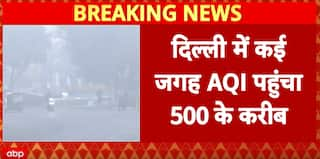Explorer
Delhi Pollution: Govt Admits High Ozone Levels, Rejects Reports Of Reduced Life Expectancy Due To Air Pollution
Ozone was a dominant pollutant in Delhi for 95 days in the last three years, the government told Parliament on Friday, while acknowledging its rising levels in the national capital.

The Union Environment Ministry also listed out the steps taken to reduce air pollution. (Image: Getty)
New Delhi: Ozone was a dominant pollutant in Delhi for 95 days in the last three years, the government told Parliament on Friday, while acknowledging its rising levels in the national capital. According to the data presented by Union Environment Minister Prakash Javadekar in the Lok Sabha, ozone was reported as a prominent pollutant for 95 days in Delhi and for 11, 48, eight and 49 days in Faridabad, Gurugram, Ghaziabad and Noida respectively in the last three years. The minister, however, rejected the reports on life expectancy being reduced in India and children dying due to air pollution and rising ozone levels, saying there was no conclusive data to establish that. Responding to multiple queries on the impact of air pollution, Javadekar said it might trigger respiratory ailments but there was nothing to establish a direct link of mortality to air pollution. "Various organisations/institutes, from time to time, have been publishing estimates of mortality/morbidity attributable to environmental pollution based on models, simulations and extrapolations. One such estimate published in 2019 reports total life expectancy loss in South Asia from air pollution to be 2 years and 6 months. However, there are no conclusive data available in the country to establish direct correlation of death/disease exclusively due to air pollution," the minister said in a written response. "Air pollution is one of the triggering factors for respiratory ailments and associated diseases. Health effects of air pollution are synergistic manifestation of factors which include food habits, occupational habits, socio-economic status, medical history, immunity, heredity etc. of the individuals," he added. Although the rise in ozone levels was one of the triggering factors for respiratory ailments and associated diseases, India did not have conclusive data yet to establish a direct correlation of mortality or morbidity exclusively due to the ozone levels, the minister said. The Union Environment Ministry also listed out the steps taken to reduce air pollution, including shifting to BS-VI compliant vehicles from BS-IV, shutting down of the Badarpur thermal power plant, banning of garbage burning, launch of the National Clean Air Programme (NCAP) and the setting up of a monitoring network for assessment of the ambient air quality at 779 locations, covering 339 cities in 29 states and six Union territories.
Follow Breaking News on ABP Live for more latest stories and trending topics. Watch breaking news and top headlines online on ABP News LIVE TV
Read more






































